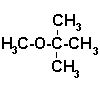 Methyl tert-butyl ether (MTBE)
has been added to gasoline formulations in recent years as an octane
booster and anti-knock compound. It also reduces carbon monoxide
emissions. However, some questions have been raised about its potential
toxicity in the environment. For more information on MTBE, consult the
Cal EPA web site
and this EPA web site.
Methyl tert-butyl ether (MTBE)
has been added to gasoline formulations in recent years as an octane
booster and anti-knock compound. It also reduces carbon monoxide
emissions. However, some questions have been raised about its potential
toxicity in the environment. For more information on MTBE, consult the
Cal EPA web site
and this EPA web site.
Therefore, interest has grown in how to analyze for MTBE along
with other gasoline compounds such as benzene, toluene, xylenes and
ethylbenzene (BTXE). EPA Method 8020, Aromatic Volatile Organics
by Purge and Trap GC/PID, is suitable for determining
MTBE. WCAS has added MTBE to our Method 8020 target list.
However, as with other PID methods, it is subject to interferences from the
hydrocarbons present in gasoline. Even second column confirmation
can yield false positives, due to the many different constituents of
gasoline. For the detection of trace MTBE in
gasoline-contaminated soils or water, we recommend EPA Method 8260,
which utilizes GCMS. GCMS gives unequivocal results for
MTBE due to its unique mass spectrum, which is easily
distinguishable from potentially interfering matrix components. The
BTXE components can also be measured in the same analysis, again
without matrix interferences. If you need to analyze for MTBE in
samples that may be contaminated with gasoline, give us a call to
discuss your options. For a
quotation......